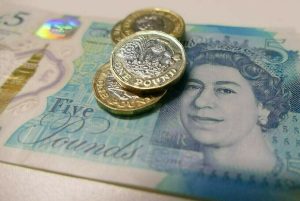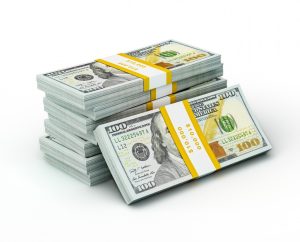STERLING INCHES UP AGAINST EURO, DOLLAR BUT REMAINS NEAR MULTI-WEEK LOWS
The British pound edged higher against the dollar and euro on Monday, but remained close to the multi-week lows it reached against both currencies last week as investor attention remains on Bank of England policy and the deteriorating fiscal picture. The pound was up 0.3% against the dollar at $1.3452, just above last week’s eight-week low of $1.33655. Britain’s economic data was mixed on balance last week – the labor market showed signs of a further cooling, while consumer price inflation unexpectedly rose to its highest in more than a year. A quarter-point rate cut from the Bank of England at its meeting on August 7 remained almost fully priced after the data, with about 50 basis points of easing priced in by the end of the year. The pound was also up about 0.2% at 86.575 pence per euro, having touched a 14-week low last week. “We think a rising fiscal risk premium is the main driver of the recent outperformance of EUR/GBP,” said Goldman Sachs FX strategists in a note. Britain remains in a precarious fiscal position, exacerbated earlier this month after the government suffered a major rebellion against welfare reforms which fed doubts about its ability to cut spending. Many economists and analysts believe the government will have to raise billions of pounds in taxes later this year to meet its fiscal rules as growth remains elusive. “The pound’s struggle to keep pace with the euro this year reflects a shift in market optimism in favour of Germany and the euro zone,” said Rabobank senior FX strategist Jane Foley. “In view of the UK’s fiscal concerns, we continue to favour buying EUR/GBP on dips,” Foley added. Deloitte on Monday said its consumer confidence index dropped to its lowest since the first quarter of 2024, reflecting increased worries about job security and income growth. Retail sales data due on Friday could give a clearer picture on the state of the consumer, while a preliminary survey of purchasing managers on business activity is set for release on Thursday.

STERLING HOLDS ON TO GAINS, INVESTORS MULL RISE IN BORROWING
The pound steadied on Tuesday, consolidating after the previous day’s rally, as investors took stock of data that showed UK government borrowing soared in June, a reminder of the fragility of Britain’s public finances. Sterling, which rose 0.6% on Monday, its biggest one-day gain in a month, was last at $1.3493, showing little change on the day. It was also steady against the euro, which was at 86.7 pence. Britain borrowed more than expected in June as high inflation added to the government’s debt costs, according to official data that is likely to add to speculation about the need for fresh tax increases later this year. Public sector net borrowing totalled 20.7 billion pounds ($27.9 billion) last month, the data showed. This compares with a forecast of 17.1 billion pounds for June from the Office for Budget Responsibility, the budget watchdog. “These overshot expectations yet again, a fact that should refocus minds on UK fiscal sustainability risks, especially after warnings by the ONS that the 20.7-billion-pound figure recorded represents ‘the second-highest June borrowing since monthly records began in 1993, after that of June 2020’,” analysts at Monex said. “As we have noted previously, this is not a sterling positive dynamic, leaving risks to the pound tilted to the downside ahead of Thursday’s PMI release,” they said. The borrowing figures added to a sense among investors that finance minister Rachel Reeves may have to raise taxes again later this year to remain on track to meet her targets for fixing the public finances. A separate report on Tuesday showed grocery inflation in Britain rose to 5.2% in the four weeks to July 13, up from 4.7% in last month’s report and the highest since January last year, heaping more pressure on UK households. Market researcher Worldpanel by Numerator, which published the report, said just under two-thirds of households say they are “very concerned” about the cost of their groceries, and are switching to supermarket own-label products. The numbers align with data last week that showed nationwide consumer price inflation picked up more than expected in June, also hitting the fastest pace since January 2024. The Bank of England is expected to cut rates by a quarter point next week and at least one more time before the end of the year.
STERLING STRONGER, SUPPORTED BY GLOBAL MARKET OPTIMISM
Sterling firmed against the dollar and the euro on Wednesday helped by the optimism across global markets after the U.S. and Japan struck a trade deal which boosted stocks and currencies, such as the pound, which can move with global growth expectations. The pound was last marginally higher against the dollar at $1.3540, its highest in nearly two weeks, and working its way back towards early July’s near four-year top of $1.3787. It strengthened more against the euro, which was down 0.24% at 86.62 pence. The big story for markets on Wednesday was a trade deal between the United States and Japan that lowers tariffs on auto imports and spares Tokyo from punishing new levies on other goods in exchange for a $550 billion package of U.S.-bound investment and loans. That boosted stocks globally, and other risk-friendly currencies such as the Australian and New Zealand dollars, as well as the pound. While the pound is still down against both the euro and dollar in July, some analysts see better days for it ahead, as markets look past the volatility in Britain’s bond market at the start of the month caused by fiscal concerns, which weighed on the currency. BofA analysts said in a note the third quarter promised to be better for the British economy. “We feel the conditions are now in place for a bounce in GBP through the summer months,” they said. “We do not understate the fragile state of UK public finances but continue to be struck by how markets are willing to find the UK guilty of fiscal breaches before being (given) the opportunity of proving innocence.” They also flagged that rate differentials were moving in the pound’s favour, and that “tariff attrition in other countries will eventually materialise.” Thursday’s business activity data, and Friday’s retail sales data will give the latest indications of the health of the British economy.
US DOLLAR RISES, BUT ON TRACK FOR WEEKLY DROP AHEAD OF FED
The U.S. dollar advanced on Friday, bolstered by solid economic data that suggested the Federal Reserve could take its time in resuming interest rate cuts, while tariff negotiations showed more clarity that eased some uncertainty in the market. The U.S. currency showed little reaction to data showing new orders for key U.S.-manufactured capital goods unexpectedly fell in June while shipments of those products increased moderately. That suggested business spending on equipment slowed considerably in the second quarter. “The dollar regained some ground the past two days, after being on the defensive earlier in the week … supported mostly by an encouraging set of U.S. economic data that argues for continued patience at the Fed,” said Elias Haddad, senior markets strategist at Brown Brothers Harriman in London. The greenback was set for its biggest weekly drop in a month, ahead of more tariff dialogue and central bank meetings next week, while sterling dipped after softer-than-expected British retail sales data. Both the Fed and the Bank of Japan are expected to hold rates steady at next week’s policy meetings, but traders are focusing on the subsequent comments to gauge the timing of the next moves. “We see some room for optimism at the (Fed) meeting,” wrote BNP Paribas in a research note. “Economic uncertainty associated with trade policy, while not entirely resolved, has declined markedly.” Politics is a factor for both central banks, most dramatically in the U.S., where President Donald Trump once again pressed for lower interest rates on Thursday as he locked horns with Fed Chair Jerome Powell. Brown Brothers’ Haddad said the Fed’s monetary policy is being “overshadowed by the political pressure to lower interest rates. That’s one of the reasons why I think the dollar’s upside is limited.” The dollar managed to recover a touch against the euro late on Thursday, however, after Trump said he did not intend to fire Powell, as he has frequently suggested he could. “The market relief was based on the fact that Trump refrained from calling for Powell to go, although that was based on Trump’s view that Powell would ‘do the right thing’,” said Derek Halpenny, head of EMEA research at MUFG. He added, however, that “the theme of Fed independence being undermined by the White House will unlikely go away and remains a downside risk for the dollar.”

STERLING AT FOUR MONTH LOW AGAINST EURO AS UK AND EURO ZONE RATES DIVERGE
The pound dropped to its weakest level against the euro in four months on Friday as a weekly decline in gilt yields on soft British data contrasted with higher European yields on expectations the European Central Bank is done with rate cuts. The euro reached as high as 87.27 pence, up 0.24% and approaching its April 11 peak of 87.38 pence, hit at the height of tariff-induced market turmoil. A break past that would take the euro to its highest since late 2023. The pound was also down 0.4% against the dollar at $1.3456. Data on Friday showed British retail sales for June were slightly below analysts’ expectations, albeit rebounding from a sharp drop in May. They followed figures on Thursday showing UK business activity grew only weakly in July and employers cut jobs at the fastest pace in five months. The jobs data is the most important aspect of this, said Derek Halpenny, head of research global markets EMEA at MUFG, as rate setters at the Bank of England are most focused on the labour market. As a result, yields on British government bonds, or gilts, are set for small weekly falls across the curve, in contrast with European government bond yields, which are up sharply on signs of a U.S.-EU trade deal and hints from the ECB that it is done with interest rate cuts. [GVD/EUR] [GB/] This “notable divergence” is sending euro/sterling higher, said Halpenny. The BoE has hitherto been much more cautious about rate cuts than the ECB and most other European developed market central banks due to stubbornly high British inflation. The ECB has cut by 200 basis points since last year, in contrast to just 100 bps from the BoE. However, while ECB could now be done with easing, markets continue to anticipate two further 25 bps BoE cuts this year and see around an 80% chance of the first of those at its early August meeting. Analysts say should UK inflation slow, the pace of cuts could accelerate. Though with inflation hitting its highest in a year in June, they say the BoE has a difficult balancing act.

- CAPITALDIGEST MARKET REVIEW , 03/11/2025November 3, 2025
- CAPITALDIGEST DAILY NEWS, 03/11/2025November 3, 2025
- CAPITALDIGEST MARKET REVIEW, 22/09/2025September 22, 2025
Enter your email address for receiving valuable newsletters.
- CAPITALDIGEST MARKET REVIEW , 03/11/2025US DOLLAR SET FOR MODEST WEEKLY GAIN AFTER SOFT INFLATION DATA The U.S. dollar was...November 3, 2025
- CAPITALDIGEST DAILY NEWS, 01/09/2025DANGOTE’S 1,000 TRUCKS ARRIVE, FUEL DISTRIBUTION TO BEGIN FROM S’WEST Barring any last-minute change in...September 1, 2025
- CAPITALDIGEST MARKET REVIEW, 11/08/2025STERLING ADVANCES AGAINST DOLLAR, EURO AHEAD OF BOE POLICY ANNOUNCEMENT The British pound climbed against...August 11, 2025












